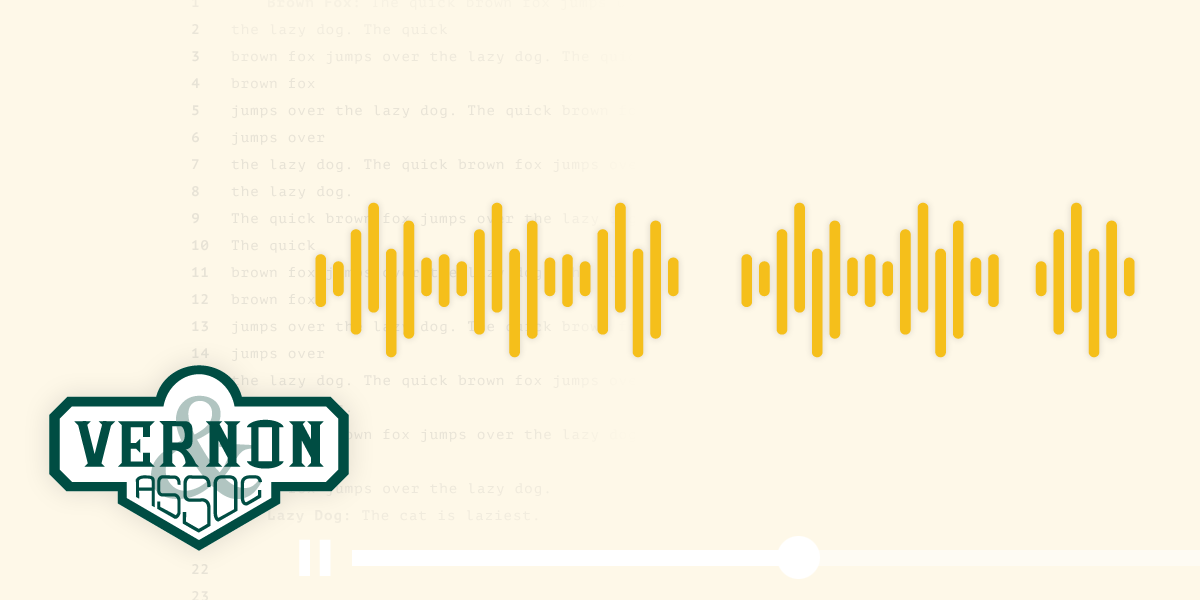What is legal transcription?
Legal transcription is the process of transcribing any type of legal proceeding from the spoken word into a written, typewritten or printed form. It involves converting court hearings, depositions, interrogations, and other law-related proceedings that are typically recorded in audio or video format into a text document.
A legal transcriptionist listens to the recordings and transcribes them, ensuring that the written version accurately reflects the spoken words, including identifying the speakers and noting any significant sounds or non-verbal communications. They must have a strong understanding of legal terminology and excellent typing and listening skills. Additionally, they need to maintain strict confidentiality and adhere to all legal and ethical standards.
Just like court reporters, legal transcriptionists play a critical role in the legal system by creating written records of legal proceedings. These records are essential for lawyers, judges, and other legal professionals to review the details of cases and make informed decisions. While court reporters are typically present during the actual proceedings, legal transcriptionists often work with recorded materials.
What types of transcriptionists are there?
Certification is not typically a mandatory requirement for transcriptionists in most industries. However, obtaining certification can be beneficial as it demonstrates your expertise, skill level, and professionalism to potential clients and employers. Some industries or niches may have higher demand for certified transcriptionists, such as:
Medical transcriptionists
Due to the specialized nature of medical terminology and the need for accuracy in transcribing medical records, certification may be more important for medical transcriptionists. The Association for Healthcare Documentation Integrity (AHDI) offers the Certified Medical Transcriptionist (CMT) and Registered Medical Transcriptionist (RMT) certifications for experienced and entry-level medical transcriptionists, respectively.
Legal transcriptionists
Legal transcriptionists work with sensitive and confidential information, and accuracy is crucial in this field. While certification is not mandatory, obtaining a legal transcription certification, such as the one offered by the American Association of Electronic Reporters and Transcribers (AAERT), can help you stand out in the job market and ensure clients of your expertise.
Real-time transcriptionists or captioners
Real-time transcriptionists and captioners provide live transcription services for events, meetings, or individuals who are deaf or hard of hearing. In these cases, certification can demonstrate your ability to transcribe accurately and quickly. The National Court Reporters Association (NCRA) offers certifications for real-time reporters and captioners, such as the Certified Realtime Reporter (CRR) and Certified CART Provider (CCP).
While certification may not be a requirement for most transcriptionists, it can be advantageous in building your reputation, showcasing your skills, and potentially opening up more job opportunities in specialized fields.
There are several certifications available for transcriptionists and court reporters to demonstrate their skills and professionalism. These certifications are typically offered by professional associations or organizations in the field. Here are some common certifications for both professions:
What are the main differences between Transcriptionists and Court Reporters?
While both transcriptionists and court reporters create written records of spoken words, there are notable differences between these two roles.
Presence at Proceedings
Court reporters are usually present at the proceedings, such as court hearings, depositions, and meetings, where they transcribe speech in real-time. They often use specialized equipment, like a stenotype machine, to keep pace with the rapid speed of spoken language. In contrast, transcriptionists, including legal transcriptionists, typically work from audio or video recordings after the event has taken place.
Equipment and Technique
Court reporters often use stenography, a method of shorthand typing, to keep up with real-time spoken words. They use a stenotype machine, which allows them to press multiple keys at once to represent whole syllables, words, or phrases. On the other hand, transcriptionists usually use a regular keyboard and transcribe word by word. They often utilize transcription software that allows them to pause, rewind, or slow down the audio or video file as needed.
Scope of Work
Court reporters often provide additional services such as real-time translation for live broadcasts or assistive services for the hard of hearing, like Communication Access Real-Time Translation (CART). Transcriptionists, conversely, primarily focus on transcribing pre-recorded audio or video content.
Specialization
Court reporting is a specialized profession with its own educational programs, certification process, and professional standards. While there are also specific programs and certifications for transcription, it’s a broader field with more varied entry paths and fewer formal requirements, particularly outside of legal or medical transcription.
Transcript Formatting
Court reporters’ transcripts often need to adhere to specific legal formatting requirements and include additional elements like an index or cover page. Transcriptionists, especially those outside the legal field, may produce transcripts with a broader range of formats.
These are general differences and there can be overlap between the two professions. For instance, a court reporter might also transcribe recorded proceedings, or a legal transcriptionist might be present at a proceeding to assist with transcription. Both roles are integral to ensuring an accurate written record of spoken language.
What kind of software can I use to transcribe audio?
There are several software options available for local transcription of audio files. Here are a few you might consider:
- Express Scribe: This professional transcription software is widely used in the industry. It supports audio and video playback and can handle a variety of file formats. Express Scribe offers variable speed playback, multi-channel control, and a series of features that can assist in the transcription process. It can be used with a foot pedal for hands-free control.
- FTR Player: FTR Player is a trusted transcription tool designed specifically for legal and court reporting professionals. It supports proprietary .TRM audio files commonly used in court recordings and offers advanced playback features, including multi-channel audio control and variable speed playback. While it’s free to use, its seamless integration with court recording systems makes it a top choice for legal transcriptionists.
- InqScribe: InqScribe offers a simple and powerful interface for transcription. You can insert time codes anywhere in your transcript and then click on them to jump back to that point in the audio. It’s compatible with both Windows and Mac.
- FTW Transcriber: Another option is the FTW Transcriber. It offers high-quality audio playback with options to adjust speed, automatic adding of timestamps, and compatibility with a wide range of audio and video file types. It also supports foot pedals.
- Listen N Write: This is a straightforward tool for transcription that’s free to use. It has a built-in media player that you can slow down or speed up as necessary. Listen N Write also allows you to insert time stamps with ease.
- Transcriber Pro: Transcriber Pro is a convenient tool for manual transcription. It supports fast transcription with keyboard controls and offers an easy way to insert time codes.
When transcribing legally sensitive material, it’s critical to ensure that the software you use complies with any applicable confidentiality and security regulations. Always double-check the privacy policies and security measures of the software.
What is the difference between Transcription and Dictation?
Transcription and dictation are two terms commonly used in relation to transforming spoken language into written text, but they refer to different processes.
Dictation is the act of speaking words out loud to be written down or typed by another person or a machine. For instance, a doctor might dictate notes about a patient’s condition, or a business executive might dictate a letter or email. In the modern context, dictation often involves the use of speech recognition technology. For example, you might dictate a text message into your smartphone, and the phone’s software translates your spoken words into written text.
Transcription, on the other hand, is the process of converting spoken language from an audio or video recording into written text. A transcriptionist listens to the recorded material and types out what they hear. Transcription is used in a wide variety of settings, including legal proceedings, medical services, and academic research.
So, the main difference between the two processes lies in the method of delivery of the spoken words. In dictation, the words are spoken directly to the person or device creating the text, while in transcription, the words are delivered via a recorded format. It’s also important to note that transcription usually requires a greater level of skill and expertise, particularly when dealing with complex or specialized language, such as in legal or medical transcription.
Transcriptionist Certifications
Registered Professional Transcriptionist (RPT)
Offered by the American Association of Electronic Reporters and Transcribers (AAERT), the RPT certification requires passing a written knowledge exam and a practical skills exam.
Certified Medical Transcriptionist (CMT)
Offered by the Association for Healthcare Documentation Integrity (AHDI), the CMT certification is designed for medical transcriptionists with at least two years of experience. It requires passing a comprehensive exam that tests knowledge of medical terminology, anatomy, and transcription best practices.
Registered Medical Transcriptionist (RMT)
Also offered by the AHDI, the RMT certification is geared towards entry-level medical transcriptionists. It requires passing an exam that covers basic medical terminology, transcription practices, and clinical knowledge.
Deciphering the Payment Structure
How transcriptionists are compensated can vary significantly. Here are the most common methods:
- Per Word: This is straightforward. You get paid for every word you transcribe. It’s a great option for fast typists, but the pay per word can be low.
- Per Line: Similar to per word, but here you’re paid for each line transcribed. This can be more lucrative if you’re dealing with dense legal material.
- Per Audio Hour: This is a common payment method where you’re paid for each hour of audio you transcribe, not the time you spend transcribing it. It’s beneficial for experienced transcriptionists who can work quickly.
- Per Page: Paying per page is common in legal transcription. This can be profitable, especially with verbose legal documents, but it requires a keen eye for detail and formatting.
Freelance Transcription Earnings Calculator
Please note that the earnings calculator provided is for estimation purposes only and is based on the number of completed pages, minutes, lines, or words. The daily rate estimation assumes the completion of a specified quantity of work. Weekly estimates are based on 5 business working days, monthly estimates on 22 working days, and yearly estimates on 250 working days.
Actual earnings may vary and depend on the actual amount of work completed and the actual number of days worked. This calculator should be used as a guideline and not as a guarantee of earnings. Your actual earnings could be more or less depending on various factors including workload, efficiency, and opportunities available.


